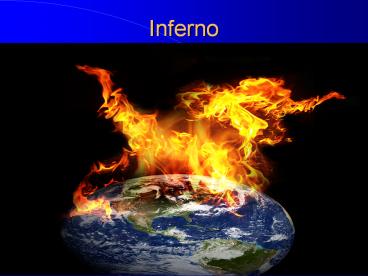Inferno - PowerPoint PPT Presentation
Title: Inferno
1
Inferno
2
Dantes Divine Comedy
- Introduction to Dante
- Reason and Faith
- Love and Free Will
- Development of Soul Body
3
Introduction to Dante
- Dante Aligheri (1265-1321), of Florence, Italy.
- One of the 4-5 greatest poets of the Western
tradition (with Homer, Virgil, Milton, Goethe). - His masterpiece (The Divine Comedy) embodies the
Thomistic synthesis of Greek philosophy the
Biblical worldview.
4
Structure of the Divine Comedy
- Three Parts
- The Inferno (Hell). A depiction of the
consequences of unchecked evil. - The Purgatorio (Purgatory). A representation of
human nature in this life (of which purgatory is
an extension) the conflict between good and
evil. - The Paradiso (Heaven). The ultimate,
supernatural end of human life. The vision of God.
5
Issues to Consider
- Love as the source of both good and evil.
- The paradox of free will is it compatible with a
scientific (Aristotelian) picture of the workings
of human nature? - The relationship between body and soul.
6
Faith Reason
- Dante gives a high status to natural reason.
- Virgil, Dantes guide through hell and purgatory,
was a pre-Christian Roman poet. - Aristotle is described as the father of them
that know. - The philosophers and poets in limbo, although
unbelievers, are treated with great respect, and
suffer only the sadness of the loss of heaven.
7
Limits of reason
- At the same time, Dante clearly asserts the
limits of reason, and the need for its
supplementation by faith. - Beatrice (representing grace) must take over for
Virgil as Dante enters heaven. - Certain mysteries (like that of free will) lie
beyond the scope of reason to explain completely. - The souls in heaven, enjoying the vision of God,
have transcended all natural limitations.
Humanity is commingled with Gods essence.
8
Love as the source of Good and Evil
- Virgil distinguishes between animal and
mind-directed love. - The second is fallible, both in respect of its
object and its intensity. - Wrong object Pride, Envy, Wrath
- Too weak Sloth (accidie)
- Too strong Avarice, Gluttony, Lust
9
Marcos Discourse (canto xvi)
- Until quite modern times, astrology was taken to
be scientific, revealing laws connecting heavenly
motions to earthly events. - If we substitute modern physics chemistry for
astrology, the same philosophical question
arises how is human freedom compatible with a
world of natural causal necessity?
10
Emergence of the rational soul
- This formative power could be identified with
the genetic information contained in the gametes
(like Aristotle, Dante hypothesizes no genetic
contribution of the mother). - As the fetal brain develops, God steps in and
creates a rational soul, which then draws into
itself the powers of the vegetative and
perceptive souls.
11
Three Medieval Theories
- Dante endorses what was known as creationism
that each individual human soul is specially
created by God. - Augustine and others endorsed traducianism the
human soul is formed by natural powers possessed
by the genes of the male and female parents. - Dante clearly rejects Averroism (ibn Ruhd) that
all human beings share a single soul.
12
Dantes Vision of Heaven
- Dantes Paradiso was based on the current,
Ptolemaic (earth-centered) model. - Dante passes through successive, concentric
circles moon, Venus, Sun, planets, fixed stars. - After reaching the primum mobile (first mover)
beyond the stars, Dantes universe undergoes a
disorienting, non-Euclidean transformation.
13
continued
- What had been the center (the earth) now becomes
the extreme periphery, and the sphere of the
primum mobile is seen to revolve around
concentric spheres of angels, centered in God. - Thus, Dantes universe is really not geo-centric
at all, but theo-centric.
14
2 major themes
- 1. Nature is the standard of good/bad,
right/wrong. - 2. The problem of the relation between self-love
and love for others.































